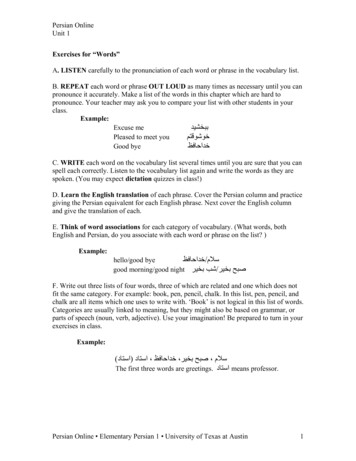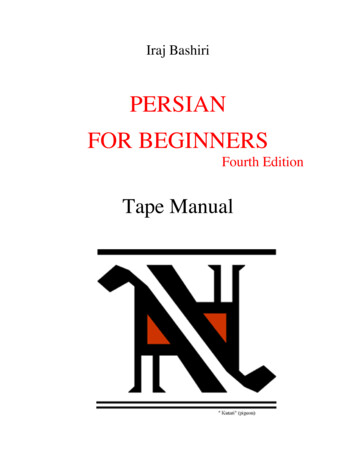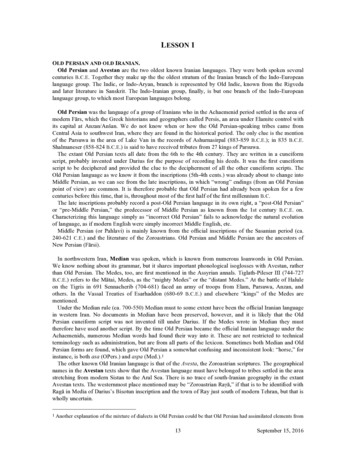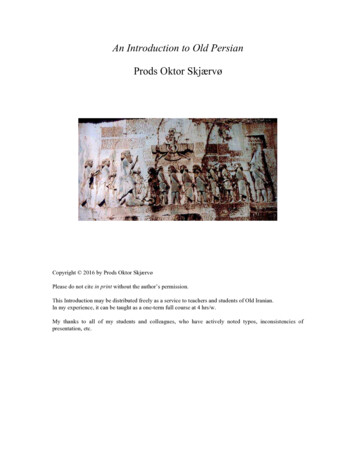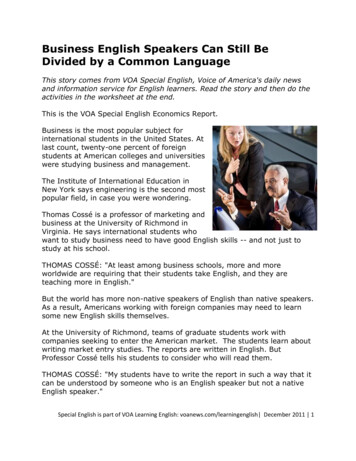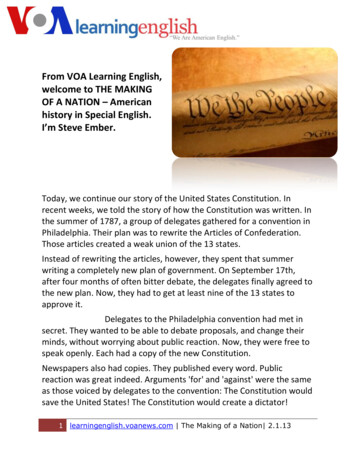
Transcription
VoA Special English for Persian Learners from thePerspective of Persian Speakers: A Critical AnalysisKhadijeh Karimi Alavijeh1, S. Susan Marandi21. Assistant professor of English Language and Literature, Alzahra University,Tehran, Iran (Corresponding author) (karimi@alzahra.ac.ir)2. Associate Professor of English Language and Literature, Alzahra University,Tehran, Iran (susanmarandi@alzahra.ac.ir)(Received: Sep. 22, 2018 Accepted: Jan. 2, 2019)AbstractUsing modern, electronic technology to promote the culture and worldview oftechnology producers and to subjugate its consumers is the gist of what McPhail(2006) calls electronic colonialism theory (ECT). As an example of electronictechnology, Internet-mediated English educational materials are rapidly growingbut they do not appear to have been critically analyzed in terms of their potentialhidden agenda. With this concern, the researchers conducted a survey study on“VOA Special English for Persian Learners” which is one of the most popularwebsites among Iranian English learners (Karimi Alavijeh, 2014). For thispurpose, all VoA lessons were closely investigated in a process of qualitativecontent analysis through which the main themes of this program were extracted.Real samples of the content were included in a 5-point, likert-type IndigenousIranian Culture Opinionnaire developed by the researchers. After making sure ofthe reliability and validity of this opinionnaire, it was responded by 151 Iranianswho had been selected through stratified random sampling from a variety ofeducational, linguistics, ethnic, religious and social backgrounds, residing indifferent Iranian provinces. To take care of the accuracy of the findings in thequantitative part of the study and to meet the triangulation criterion in thequalitative phase, in depth semi-structures interviews were also conducted. Theanalysis of the obtained data revealed the incongruity of the supposedly “specialfor Persian learners” materials with Iranians’ values, supporting ECT in the sensethat this program plainly serves the promotion of American culture among theIranian learners.Keyword: Electronic colonialism theory (ECT), Indigenous Iranian CultureOpinionnaire, Internet-mediated English education, Interview, VoA SpecialEnglish for Persian Learners 1Journal of World Sociopolitical Studies Vol. 3 No. 1 January 2019 pp. 109-159Web Page: https://wsps.ut.ac.ir//Email: wsps@ut.ac.ireISSN: 2588-3127PrintISSN: 2588-3119DOI: 10.22059/wsps.2019.278601.1099
Khadijeh Karimi Alavijeh, S. Susan MarandiJournal of WORLD SOCIOPOLITICAL STUDIES Vol. 3 No. 1 January 20191101. IntroductionThe Internet and English language education are no stranger to oneanother. As the greatest and innovation in information technology,the Internet has offered language learners and teachers newopportunities that have never been preceded by other technologies.Among the numerous advantages of the Internet in service oflanguage learning, one can point to the following: the multimediaand interactive capabilities of web pages, which offer games andentertainment alongside texts in English, the increasing ubiquity ofthe Internet, the high speed of information transfer and retrieval,and the possibility of using diverse information for learning thefour language skills in integrative way. Furthermore, using theinternet for language learning, one can benefit from the chance ofinteraction with native and non-native speakers, the possibility ofreceiving on-the-spot feedback and corrections, and the promotionof autonomous and individualized as well as peer learning. Internetalso encourages teaching and learning that are independent fromrestricted source books and course materials; learning materials arerelatively easy to access, and allow users to benefit from abundantsources of information such as online journals, newspapers,magazines, books, dictionaries, and encyclopedias. The providetheir users with social networking tools and listservs, as well asvarious online satellite, TV and radio channels. These elementsmake the Internet an all-inclusive learning package, which isconsiderably popular among English learners (Lee, 2000;Morrison, n.d.; Singhal, 1997).Influenced by the considerable possibilities that the Internetoffers to its users, ELT researchers seem to have overlooked itspotential threats and disadvantages. Critical views toward Internetmediated ELT, unfolding hidden agenda in English educational
programs available on the Web (Karimi Alavijeh & Marandi,2014), hegemonies in technology-enhanced ELT (Lamy & Pegrum,2012; Marandi, Karimi Alavijeh & Nami, 2015), and colonialismand cultural subjugation in ELT on the Web (Karimi Alavijeh,2014) have just started to attract researchers’ attentions. Suchcritical perspectives are both relevant and significant, since theInternet has a high potentiality for disseminating Western values(Anbarian, 1388 [2009 A.D]; Jordan, 2013; Le’vy, 2001),especially those of English speaking countries throughout the world(Anderson, 2004; Castells, 2001; Reeder, Macfadyn, Roche &Chase, 2004).Accordingly, the present study seeks to explore the culturalpolicies of VoA Special English for Persian Learners, which isamong the four most popular English educational programs amongIranian learners of English (Karimi Alavijeh, 2014). Takingadvantage of qualitative and quantitative approaches, this studyuses the main tenets of Electronic Colonialism Theory (McPhail,1987, 2006) as its theoretical foundation, coupled with qualitativecontent analysis, opinionnaire development, completion andanalysis, as well as semi-structured interviews as its data collectionmethods.2. Review of literatureThe spread of the culture and ideology of English-speakingcountries in the process of English language education has been theconcern of many critical ELT thinkers (e.g., Adaskou, Britten &Fahsi, 1990; Asraf, 1997; Block & Cameron, 2002; Canagarajah,1999, 2007b; Fairclough, 2006; Heiman, 1994; Pennycook, 2007a,b; Pennycook & Coutand-Marin, 2005; Phillipson, 1992, 2009).These researchers have tried to draw their readers’ attention toward111Journal of WORLD SOCIOPOLITICAL STUDIES Vol. 3 No. 1 January 2019VoA Special English for Persian Learners from the Perspective of PersianSpeakers: A Critical Analysis
Khadijeh Karimi Alavijeh, S. Susan MarandiJournal of WORLD SOCIOPOLITICAL STUDIES Vol. 3 No. 1 January 2019112the efforts that certain Western countries have made throughouthistory to establish their dominance over the world throughdifferent strategies, such as conquering the lands of non-Englishspeakers, taking control of their educational and cultural centers,dominating their culture, history, thinking system, and lifestyle, andcharacterizing and representing them in false, unrealistic manners.The hegemonic ambitions that English-speaking powers seek inELT have been discussed in various studies as a part of the English“hidden curriculum” Project (Jackson, 1968). Coining the term“linguistic imperialism”, Phillipson (1992) proposed that ELT ingeneral is an imperialistic project, which aims to boost Westerncommerce, and disseminate Western culture and ideology mainlythrough global English textbooks supported by Westerngovernments. Hidden agenda in English textbooks markets wasdiscussed by researchers such as Spring (2009) and Ehrensal(2001) who also warned against the threat of Western culturestaking the place of local cultures.From among a variety of issues in this regard, the followingtopics represent a number of contemporary ELT concerns:marketing English language information through commercialtextbooks as a way of controlling knowledge and presenting it asunquestionable (Battiste, 2013; Parat et al., 2018; Park & Wee,2012; Progler, 2011; Spring, 2009), and propagating the US familyand social values as well as their social order, rules and norms asthey are represented in American English textbooks (Arkian, 2005,2008; Gray, 2000; Holme, 2003). The most important role ofEnglish textbooks produced for use in developed countries isenhancing the spread of the West’s culture (Aliakbari, 2004;Cunningworth, 1995; Holly, 1990; Kakavand, 2009; Kilickaya,2004; Rahimi & Yadollahi, 1389 [2010 A.D]); Sadeghi, 1387
[2008 A.D]). English learners’ frustration with contemporaryEnglish textbooks is due to the incongruity of the English cultureeither with their indigenous value system and lifestyle, or with thelocal programs’ goals and needs (Brown, 2001; Canagarajah, 1999,2005; Poursadouqi, 2012; Sadeghi, 1387 [2008 A.D]).Consequently, many English language instructors recognize theneed for including indigenous culture (Adaskou et al. 1990; Chenet al., 2011; Cortazzi & Jin, 1999; Hajjaj, 1985; McKay, 2003) orinternational culture (Bashir, 2011; Cortazzi & Jin, 1999; Kiss &Weninger, 2013; McKay, 2003; Naji & Pishghadam, 2013) inEnglish textbooks.As the preceding discussions reveal, one of the main concerns ofcritical ELT is textbook. While Internet-mediated Englisheducational materials are gradually taking the place of traditionaltextbooks, few studies have been devoted to their critical analysis.What adds to the imperative need for such critical studies is theskepticism raised as a result of the significant investments of theWest in producing online English educational programs. In fact,producing multimedia English educational programs, publishingthem on the Web, constantly revising, updating, and incurring highcosts of domain purchase and site maintenance demandsconsiderable funds. Nevertheless, surprisingly, most of the Internetmediated English educational programs are completely or partiallyfree (Karimi Alavijeh, 2014). It would seem rather naïve, then, tothink of online English educational programs as the generousbenevolence of Western countries to exotic Other users(Pennycook, 1998, 2010).This skepticism becomes even more serious when the history ofcolonialism reveals the efforts of the West to make either colonies,or protectorates or dependencies out of Other nations. Many critics113Journal of WORLD SOCIOPOLITICAL STUDIES Vol. 3 No. 1 January 2019VoA Special English for Persian Learners from the Perspective of PersianSpeakers: A Critical Analysis
Khadijeh Karimi Alavijeh, S. Susan MarandiJournal of WORLD SOCIOPOLITICAL STUDIES Vol. 3 No. 1 January 2019114believe that this colonial relation persists, although through modernmeans (e.g., Canagarajah, 2007a; Giddens, 2000; Hamelink, 1983;Schiller, 1976; Tomlinson, 1991). They hold that while countriessuch as the US still make use of the old colonizing tool, i.e., themilitary power, to subjugate nations, they also exercise theirtechnological power to dominate the globe. The use oftechnological privilege by the West to dominate the world hasextensively been discussed by McPhail (1987, 2006) in his theoryof electronic colonialism. This theory is related to the current studymainly in that the Internet is the central aspect of McPhail’s theory.3. Electronic Colonialism Theory (ECT)Electronic colonialism is a theory that refers to the dominantrelation of electronic technology producers over technologyconsumers, which is established by the importation ofcommunication software, hardware and technicians from theformer to the latter (McPhail, 2006). “On one level, electroniccolonialism examines economic transactions through which anumber of large multinational communication corporations engagein the selling of culturally embedded goods and services abroad”(McPhail, 2006, p. 353). On another level, ECT looks at the social,cultural, and political impacts of these economic activities. ECTargues that these products largely contribute to “attitude formation,particularly among young consumers who seek out foreign culturalproducts, ranging from comic books, to music, to videos, whichrepresent distant cultures and dreams–products that are producedand manufactured primarily in a totally different environment,culture”, (McPhail, 2006, p. 354) and often in the Englishlanguage.According to McPhail, the technological dependency of the
electronic technology consumers on its producers revives the samedependence relations present in the colonial era. As the countries atthe receiving end of technology transfer import the Western culturevia the new technology, they are absorbed by the charm andfascination of the new culture and modern lifestyle. The importedlifestyle naturally demands its new means, devices and implements,most of which are not producible in home countries due to the lackof the necessary technology. In such circumstances, the culturaldemands create profitable markets for Western goods, which itselfleads to economic and political dependence on the West. Hence,ECT discusses the vicious circle of cultural fascination on the onehand, and economic-political dependence, on the other hand.Tightly interwoven, cultural, political and socio-economic factorsenhance each other to maintain the Western dominance over theglobe through electronic colonialism.McPhail points out to the fact that all types of global media,including the Internet, are collectively influencing the minds,attitudes, values, beliefs, lifestyles, and languages of individualsaround the world. Internet, similar to other mass communicationtools, delivers with it the “trappings of an alternative lifestyle,culture, mental set, economy, or political messages that goes farbeyond the momentary image flickering on a screen” (McPhail,1987, p. 18). Thus, McPhail uses ECT to examine “the mentalimages, and the long term consequences of exposure to software ofall types” (McPhail, 1987, p. 19).ECT considers mass media as the central reference point ofmodern Western colonialism. This is mainly since the mass mediaare the most feasible instruments through which people’s mindscan be manipulated, especially at the present time, when theInternet-enhanced media are constantly expanding in terms of115Journal of WORLD SOCIOPOLITICAL STUDIES Vol. 3 No. 1 January 2019VoA Special English for Persian Learners from the Perspective of PersianSpeakers: A Critical Analysis
Khadijeh Karimi Alavijeh, S. Susan MarandiJournal of WORLD SOCIOPOLITICAL STUDIES Vol. 3 No. 1 January 2019116technical power, penetration, and coverage. Mass media areinfluential in maintaining the Western dominance through theglobal spread of the Western culture, in a way that ‘mediaimperialism’ is taken by many as a form of neo-imperialism, as asubcategory of cultural imperialism by others, and even anotherterm for cultural imperialism by a third group of thinkers andmedia theorists (Tomlinson, 1991).Another facet of mass communication policies, adopted mainlyby the Western news services, is the misrepresentation of peripherycountries as a result of bias and distortion. According to ECT,various periphery countries feel that they are misunderstood notonly in the West, but also in other periphery countries thatsubscribe to these Western news agencies. For instance, McPhail(1987) asserts that the news about the successful growth anddevelopment of periphery countries goes uncovered while the newson war, terrorism, disasters, poverty, coups, crime, violence,diseases and the like is abundant (also see Behnam & MoshtaghiZenouz, 2008; Ghiasian, 1389 [2010 A.D]); Rashidi & Rasti, 2012;van Dijk, 1998). Since a major facet of ECT is culturalsubjugation, culture in English pedagogy is briefly reviewed in thefollowing section.3.1. The place of culture in ELTTo study the place of culture in ELT literature, it is important tofirst define culture. By culture, we mean “the context within whichpeople give meaning to their actions and experiences, and makesense of their lives” with regard to an underlying ideology(Tomlinson, 1991, p.7). No one denies the intertwined connectionbetween language and culture (Brown, 2001; Damen, 1987;Halliday, 1978; Hong, 2005; Kramsch, 1998a, 1998b; Palmer &
Sharifian, 2007; Tang, 1999; Thanasoulas, 2001) and the fact thatlearning any language implies learning, to varying degrees, theculture of the speakers of that language (Brooks, 1968; Brown,2001; Kramsch, 1993; Peck, 1998; Thanasoulas, 2001). However,there are diverse views as to whose culture to include in Englishtextbooks; these views are briefly discussed below:3.1.1. English materials including target cultureEnglish materials containing cultural information about Englishspeaking people make up the typical textbooks traditionally used inELT (Byram, 1997; Cortazzi & Jin, 1999; McKay, 2003). McKay(2003, p. 10) relates this to two factors: “1. English textbooks areoften published in English-speaking countries; 2. Target culture isassumed to be attractive and motivating to English learners.” Somescholars believe that English learning is English culture learning,and that culture has always been taught in English classes, evenimplicitly (Kramsh, 1993; Thanasoulas, 2001).Tomalin & Stempleski (1993, pp. 7-8) suggest that it is“needed” to incorporate the target culture in foreign languageteaching in order to help foreign/second learners understand the fact that all people’s behaviors are “culturallyconditioned;” increase their awareness of conventional behaviors in the targetculture; discover how social variables such as age, sex, social class, etc.influence the way people talk and behave; increase their awareness of the culture-specific connotations oftarget language phrases and expressions;117Journal of WORLD SOCIOPOLITICAL STUDIES Vol. 3 No. 1 January 2019VoA Special English for Persian Learners from the Perspective of PersianSpeakers: A Critical Analysis
Khadijeh Karimi Alavijeh, S. Susan MarandiJournal of WORLD SOCIOPOLITICAL STUDIES Vol. 3 No. 1 January 2019118 constantly refine their evaluations and generalizations about theforeign culture; develop their skills in locating target cultural points andorganize them; promote their “intellectual curiosity” about the target culture; develop an empathy toward the people practicing the targetcultureSimilarly, Byram (1993, p. 14) states that when the cultures ofthe interlocutors are different, “communication is only possible if atleast one of them understands the other culture.” He suggests thatan awareness of the similarities and differences between twocultures leads to “successful communication and interculturalunderstanding” (Byram, 1993, p. 15).3.1.2. English materials including source cultureCertain ELT scholars argue for the use of English materialscomprising of cultural topics from the source country for a varietyof reasons such as the following: 1. English materials includingtarget culture may be “largely irrelevant, uninteresting,” or“confusing” (McKay, 2003, p. 10) to English learners; 2. Materialsfrom source culture can enhance English learners’ ability to shareinformation about their community and culture with Englishlearners from other cultures; 3. While bilingual English teachersusually find it difficult to talk about target culture in their Englishclasses due to their lack of particular knowledge about the targetculture, they can simply manage the source-culture content; 4.English materials with source-culture content minimize themarginalization of indigenous “values and lived experiences” ofEnglish learners (McKay, 2003, p. 19).
The source culture proponents argue against teaching Englishculture for other reasons including the threat of English culture fornative culture and identity (Ehrensal, 2001; Holliday, 1992, 1994;Modiano, 2001; Spring, 2009), the one-way direction of culturaltransfer (Cook, 1999; Holliday, 1992), the artificiality of Englishclasses (Banks, 2001; Dat, 2006), and the redundancy of cultureteaching in many foreign and international settings (Brown, 2001;Dat, 2006). In addition, cultural content in English courses usuallypresents limited, unilateral and superficial aspects of the targetculture (Banks, 2001; Lappalainen, 2011; Pohjanen, 2007; Yim,2003), as well as optimistic representation of the target culture’sideals rather than realities (Banks, 2001; Bashir, 2011; Ehrensal,2001). It portrays limited ethnic and cultural groups (Banks, 2001;Bashir, 2011), and encourages cultural relativity, which leavesEnglish learners insecure, hesitant, and skeptical about theircultural values (Brown, 2001; McKay, 2003), and promotes thehegemony of American and British culture (Alptekin, 1993;Widdowson, 2004). In such ways, the cultural content used inEnglish classes seems to enhance neocolonialism through capturinglearners’ minds (Canagarajah, 1999, 2007a, 2007b; Kubota, 1999;Pennycook, 1998), and promotes cultural imperialism (Holliday,1992, 1994; Modiano, 2001; Pennycook, 1994; Phillipson, 1992,1997, 2009; Tomlinson, 1991).It is almost three decades that the need for source culture contentin English textbooks has been recognized, basically since “it is theusers’ cultural content and their sense of appropriate use of Englishthat should inform language pedagogy” (McKay, 2003, p. 13).Today, there is a growing concern for addressing this need at thenational level in numerous countries such as Cameron, India, SaudiArabia, Turkey, Kuwait, Morocco, Chile, Venezuela and Yemen(Adaskou et al., 1990; Aliakbari, 2003; Chen et al., 2011; Cortazzi119Journal of WORLD SOCIOPOLITICAL STUDIES Vol. 3 No. 1 January 2019VoA Special English for Persian Learners from the Perspective of PersianSpeakers: A Critical Analysis
Khadijeh Karimi Alavijeh, S. Susan MarandiJournal of WORLD SOCIOPOLITICAL STUDIES Vol. 3 No. 1 January 2019120& Jin, 1999; Hajjaj, 1985; McKay, 2003). In Iran, efforts have beenmade to exclude Western cultural values from English textbooks,and include, instead, those of the Iranian nation and civilization(Aliakbari, 2003, 2004; Keshavarz & Akbari Malek, 2009; Khajavi& Abbasian, 2011; Riazi & Mosallanejad, 2010; Sadeghi, 1387[2008 A.D]).3.1.3. English materials including international cultureTo make up for the unilateral inclusion and portrayal of eithertarget or source culture in English materials (Banks, 2001; Dat,2006), there exists a third alternative: using international culture, orusing a large variety of cultures from English and non-Englishspeaking countries in English textbooks (Bashir, 2011; Cortazzi &Jin, 1999; Kiss & Weninger, 2013; McKay, 2003; Naji &Pishghadam, 2012). The use of international culture in textbooks isalso a response to the cultural diversity of many Englisheducational settings, which calls for cultural pluralism (Atkinson,1999; Kramsch, 1996; Lazaraton, 2003).Cortazzi and Jin (1999) suggest that this latter type of materialshas the advantage of training learners for cross-culturalcommunication. McKay (2003) holds that in addition, to illustratehow various forms of English can be used by bilinguals forinternational communication, such materials can also demonstratelexical, grammatical, and phonological variations of currentEnglishes. It can present how English is used to fulfill a wide rangeof pragmatic functions in cross-cultural settings, where people canobserve their own rules of appropriateness (Cortazzi & Jin, 1999;McKay, 2003).In her study about the representation of the target cultures (theUS, UK, and Australia) in Finnish EFL textbooks, Pohjanen (2007)
suggested that the presentation of the target cultures in textbooksdoes not fulfill the expectations of intercultural education.Similarly, Yim (2003) studied the Korean EFL textbooks andconcluded that their textbooks encouraged “Americanization” andcultural “homogenization,” and that they failed to promotediversity and a sense of multicultural education (Yim, 2003, p.185). Both scholars call for employing a variety of culturesincluding those of the source and target languages in Englishtextbooks. Naji and Pishghadam (2013, p. 93) examine parts offour popular series of textbooks published in a time span of 12years. They suggest that recent textbooks adhere more to theprinciples of English as an international language, in that they“generally try to depict more aspects of the expanding and outercircle countries”.Since VoA has developed an Internet-based programparticularly “for Persian learners,” and because its approach, as itwill be observed later in this paper, is the inclusion of the targetAmerican culture in English materials, it sounds worthwhile tobring this program under close examination.4. Methodology4.1. Corpus: VoA Special English for Persian LearnersVoice of America is the “official external broadcast institution”(Voice of America, n.d.) of the US government. It produces a widerange of programs for radio, television and Internet broadcastoutside the US in 43 languages for an estimated global audience ofabout 123 million people overseas. VOA has a special Englishlearning program for Persian learners as well as for Chinese,Indonesian, Russian and Vietnamese learners. They are completely121Journal of WORLD SOCIOPOLITICAL STUDIES Vol. 3 No. 1 January 2019VoA Special English for Persian Learners from the Perspective of PersianSpeakers: A Critical Analysis
Khadijeh Karimi Alavijeh, S. Susan MarandiJournal of WORLD SOCIOPOLITICAL STUDIES Vol. 3 No. 1 January 2019122free and can be retrieved either through the homepage of VOA ordirectly via their links such as http://farsi.goEnglish.me, used forPersian learners of English. This latter website includes eightylessons broken into three levels of beginner, intermediate andadvanced. The homepage of this website appears below.Figure 2: The homepage of VoA Special English for Persian Learners4.1.1. InstrumentationThe instruments employed in this study are an opinionnaire andsemi-structured interviews, which will be described in thefollowing section.4.1.1.1. Indigenous Iranian Culture OpinionnaireIn the course of the study, it was observed by the researchers thatVoA Special English for Persian Learners is replete with issues
about the American culture, fully explained and exemplifiedthroughout the lessons. This significant exposure to cultural issueswas suspicious for a “language program,” especially since thisprogram was designed for “Persian” learners of English. Theresearchers therefore developed an Indigenous Iranian Cultureopinionnaire (available in Appendix I) to investigate the way inwhich the Iranian people related the cultural issues included inVoA to their indigenous culture.To help the respondents have a real sense of the VoA materials,we exposed them in the opinionnaire to the VoA excerpts inverbatim. The opinionnaire consisted of 42 items on a 5-pointLikert-type scale indicating much congruence, congruence, partialcongruence, incongruence, and contradiction between theAmerican cultural issues and the indigenous culture of therespondents. Moreover, space on the last page of the opinionnairewas devoted to respondents’ more explanations. Since respondentsdid not all have a good command of English, the instructions wereprovided in Persian; all excerpts in the items were also provided inboth English and Persian. To cross check the correctness of givenresponses, seven reverse items were designed. Moreover, theopinionnaire included a variety of cultural issues, which seemed tothe researchers to cover both the points that are in congruence withand in contradiction to respondents’ indigenous culture. Thiswould decrease the chance of marking all items in the same way.The opinionnaire was revised several times during a process ofconsulting experts in TEFL, Persian language, cultural studies andresearch methods. Eventually, in a pilot phase, the first draft of theopinionnaire, consisting of 51 items was responded by fiftyIranians who were similar to the target population for whom theinstrument had been designed. After the administration, a post hocanalysis helped screen out the items which had not worked123Journal of WORLD SOCIOPOLITICAL STUDIES Vol. 3 No. 1 January 2019VoA Special English for Persian Learners from the Perspective of PersianSpeakers: A Critical Analysis
Khadijeh Karimi Alavijeh, S. Susan MarandiJournal of WORLD SOCIOPOLITICAL STUDIES Vol. 3 No. 1 January 2019124properly, resulting in a 42 itemed opinionnaire (available inAppendix I). The internal consistency reliability was then measuredby Cronbach Alpha Coefficient, which was 0.81. The contentvalidity was also checked by one linguistics and three TEFLexperts, who confirmed that items were clear, relevant andappropriate for the purpose of the study.4.1.1.2. Semi-structured interviewsThirty-two participants attended the interviews through which theyexpressed in Persian their views towards the cultural issuespresented in VoA for Persian learners. Semi-structured questionsallowed for focused conversations coupled with enough flexibilityand acceptance without giving the participants a head start in anydirection. During the interviews, the participants were put at ease totalk about their understanding of cultural issues; the main themesextracted from VoA, which were also included in the opinionnairewere used to guide the research. The participants were alsosuggested to look through the VoA website for as much time asthey wished, while the researchers were at their disposal for anykind of help. They were rather astonished with this experience:nine participants spent more than 40 minutes watching thisprogram on researchers’ PC. Except for these cases, interviewsgenerally lasted about 45 minutes; all interviews were recorded,transcribed and translated into English by the researchers.4.1.2. ParticipantsTo collect data, we needed a sample to be a reliable representativeof the entire Iranian population, in a way that we could judge theway in which particular cultural values taught in VoA Special
English for Persian learners conformed to the Iranian culture. Forthis end, we used stratified sampling as our data collection method.Iran has 31 provinces with a variety of ethnic groups and theirrelated life styles, customs, traditions, languages and dialects.Usuall
"VOA Special English for Persian Learners" which is one of the most popular websites among Iranian English learners (Karimi Alavijeh, 2014). For this purpose, all VoA lessons were closely investigated in a process of qualitative content analysis through which the main themes of this program were extracted.
